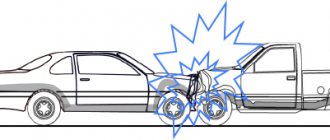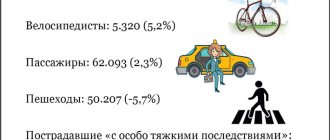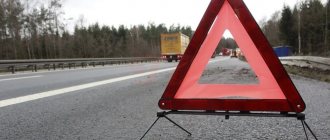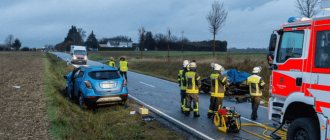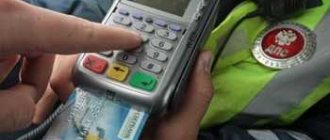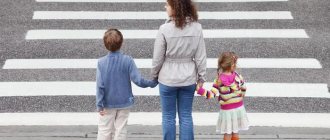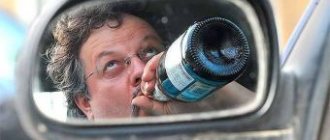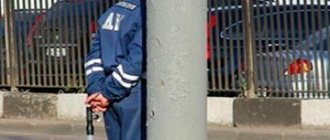Every day you and I become participants in traffic: we travel by public or private transport, bicycle, or simply cross the roadway. At the same time, we must remember that the road is a source of danger, so we need to be very careful and follow the traffic rules. Too frivolous an attitude towards such a seemingly everyday thing can lead to unpleasant consequences - a traffic accident.
Road traffic accident - what is it?
The Road Traffic Rules (hereinafter referred to as traffic rules) give the following definition of an accident (clause 1.2): “An event that occurred during the movement of a vehicle on the road and with its participation, in which people were killed or injured, vehicles, structures, cargo were damaged or other material damage was caused.”
Let's look at it in more detail.
Firstly, an accident is an event, that is, a phenomenon of life that does not depend on the will of people. In other words, something that we would not want to allow, but it happened despite our desire. At first glance, this is an insignificant nuance, but for lawyers it will be important to establish the fact of the “event”, since it will characterize the accident as an accident. Suppose two cars driving behind each other, braking at a traffic light, collided. If the driver behind simply did not have time to brake, say, due to bad weather conditions, that is, he did not want such consequences to occur, then what happened will be an “event.” And further proceedings and the extent of liability of the violator (in this case, restoration of material damage) will depend on this. And if the collision is committed deliberately, that is, at the request of the driver (in the language of lawyers, an “action” will be committed), then in the legal sense the situation changes radically: the driver has violated not just public order, but has encroached on someone else’s life or property, therefore there will be subject to harsher criminal penalties.
Secondly, a vehicle is involved in an accident, and it must move. These two criteria must be met simultaneously. Agree that if hooligans scrawl a bad word on a car parked under the window, then this situation will not be an accident, although your vehicle “participated” in it (the guys will simply be held accountable for damaging someone else’s property). In this case, an important sign of an accident is missing - the movement of the car.
Thirdly, an accident necessarily leads to negative consequences - causing damage (material or damage to health or life). For example, if a pedestrian ran onto the roadway, but the driver managed to brake and did not hit the traffic violator, then such a situation will not be regarded as an accident, because no harm was caused to anyone (except that both escaped with only a slight fright).
Thus, we see that an accident has three main signs:
- Occurs regardless of the will of the participants in the accident.
- One of the participants is a vehicle that is in motion, on the road.
- As a result of an accident, any damage is caused.
An accident is...
I'll start right away with an example. Let's say the lights suddenly went out in the entire neighborhood. We sigh and say: “There must have been an accident at the substation.” Or the car driver lost control and ran into a roadside pole. And in this case we say that an accident occurred.
Consequently, an accident is an abnormal (not occurring regularly) event in the form of destruction, breakdown, explosion, which entails the onset of any negative consequences or creates the likelihood of such consequences (potential danger).
If it led to serious material damage and (or) harmed the health or lives of people, then they say that it provoked the creation of an emergency situation (emergency situation). That is, it was the first link in the chain of cause and effect “Accident → Emergency”.
In fact, they are not the same thing. An emergency can be a consequence - for example, the accident at the Chernobyl nuclear power plant caused a large-scale emergency. Or the accident may be the result of an emergency - for example, an earthquake and tsunami caused an accident at a nuclear power plant in the Japanese city of Fokushima.
The higher humanity climbs the ladder of scientific and technological progress, the more the likelihood of accidents increases.
This is logical, because more and more new technologies and new mechanisms are appearing, and accordingly, the percentage of the probability of their breakdowns is increasing. This does not mean that innovations will necessarily break, only that the likelihood of this happening increases.
I will not explain the essence of probability theory, but I will explain what was said with an example. Let's say there are no household appliances in your house. Therefore, the probability that one of them will break is “0”.
You bought a TV. There was a possibility that it might break. And if you bought 9 more household appliances, then the likelihood of a breakdown (compared to the time when you lived in an empty apartment) increased 10 times!
Therefore, if your great-grandmother says that there were no accidents in her time, then this is the absolute truth. After all, when there is nothing to break, nothing will break.
Some terminology:
- If any technical object is on the verge of destruction, breakdown, or destruction, then such an object is said to be in emergency condition.
- Emergency repair is a repair intended to eliminate the consequences of an accident that has already occurred, or to prevent it.
- Emergency service is a department whose main purpose is to perform emergency repairs.
- Accident rate is the probability of an accident occurring.
- Emergency protection is a set of means and methods to prevent it.
- An emergency source of electricity is equipment capable of supplying an object with electricity for some time when its main source is turned off.
Causes of road accidents
- The most common reason is violation of traffic rules by vehicle drivers. Most often, the following violations lead to emergency situations: Excessive speed. Often, drivers do not comply with the established speed limit, which sometimes leads to dire consequences. When choosing a speed, always take into account the situation on the road, weather conditions and other factors. And remember the popular wisdom: “The slower you go, the further you will go.”
- Violation of overtaking rules. Overtaking is a rather responsible maneuver. Therefore, before you start, you need to make sure that it will be safe for you and other road users. And, of course, you need to follow the simple rules specified in section 11 of the traffic rules: do not start overtaking if the car in front or behind you has already started it, or you doubt that you can safely complete the maneuver; Do not overtake at intersections, railroad crossings, or pedestrian crossings.
A common consequence of failure to comply with overtaking rules is a head-on collision.
- Failure to maintain distance. According to paragraph 9.10 of the traffic rules, the driver must maintain a distance “that would allow him to avoid a collision.”
- Drunk driving. The minimum liability for this violation: a fine of 30,000 rubles and deprivation of the right to drive vehicles from 1.5 to 2 years (Article 12.8 of the Code of Administrative Violations of the Russian Federation). If people were injured due to such driving, then the punishment may result in a prison term (Article 264 of the Criminal Code of the Russian Federation).
Indirect reasons include unreasonably risky behavior on the road, inability to control oneself in an emergency situation, poor physical/mental condition of the driver (illness, fatigue, stress). By and large, they lead to any reason from the list, but they are also worth paying attention to.
Types of accidents
Analyzing the situations in which car drivers most often got into accidents, we can distinguish the following types:
- Collision. A distinction is made between collisions between two moving vehicles (car, electric car, motorcycle and other mechanical vehicles), collisions between a moving vehicle and another that has suddenly stopped, collisions with a train;
- Collisions A collision with a pedestrian (even if it was his fault that he collided with a car);
- Hitting a cyclist;
- Colliding with a stationary vehicle. Please note that the vehicle was not in motion, but was initially standing at the time of the accident (for example, in a parking lot). This is in contrast to a collision where the vehicle was en route but stopped suddenly, for example by braking in front of a pedestrian crossing;
- Hitting or hitting an obstacle;
- Collision with horse-drawn vehicles;
- Hitting animals (wild, domestic, and also birds; including the case when they themselves hit a car);
Road accident registration by Rosstat
Rosstat Order No. 887 dated December 29, 2017 “On approval of methodological provisions for transport statistics” (this order was not officially published) contains the following provisions:
- Deceased - a person who died at the scene of a traffic accident or died within 30 days after the accident.
- Wounded - a person who received bodily injuries at the scene of a road traffic accident, which led to his hospitalization for a period of at least one day, or the need for outpatient treatment.
State statistical reporting on road traffic accidents includes information only on road traffic accidents in which people were killed or injured.
Road traffic accidents are taken into account according to the following main criteria:
- types (collision, rollover, collision with a standing vehicle, pedestrian, obstacle, cyclist, passenger fall);
- places of commission (in populated areas, on public roads, private roads, toll roads, non-public roads, at railway crossings and other places);
- reasons, the main of which are: violation of traffic rules (including by vehicle drivers), technical malfunction of vehicles and unsatisfactory conditions of maintenance and arrangement of the road network;
- categories of victims (drivers, cyclists, passengers, pedestrians);
- participants in incidents (including those involving pedestrians and children under 16 years of age);
- time of occurrence (days of the week, time of day).
Actions in case of an accident
What a driver involved in an accident should do is described in Section 2 of the Traffic Regulations.
The exact course of action depends on the situation, but in any case you need to do the following:
- Stop the car or leave the place, depending on the situation.
- Turn on the emergency lights and put up a warning triangle.
If an accident occurs, you need to stop the car and turn on the hazard lights
- Do not touch anything at the scene of the accident. If a car involved in an accident interferes with normal road traffic, then the roadway must be cleared. Before doing this, it is advisable to take photos or videos of the accident site, the location of vehicles on the road, damage and other important details of the accident.
In case of an accident, the driver must place a warning triangle on the road
- Report the incident to the police and wait for further instructions.
- If necessary, help the victims of the accident, call an ambulance.
Actions after an accident
The procedure for the actions of participants in an accident after the incident is determined by clauses 2.6 - 2.6.1 of the Traffic Regulations. In general, the drivers involved are required to:
- stop driving and leave the car at the stop;
- turn on the hazard warning lights;
- install a warning triangle;
- leave all objects related to the accident in their places (save scree, flying and fallen objects, etc.).
If there are victims, you need to provide them with first aid, call an ambulance and the police at cell numbers 103 and 102 or the single number 112, if necessary, send them to the nearest medical facility with passing transport, and in its absence, take them yourself and return to the place.
Turning on the hazard warning lights and installing a sign - the first actions after an accident
Drivers are required to clear the road after recording the initial location of the vehicles (including by taking photos and videos):
- in case of injury or death of people only in cases where the passage of other vehicles is impossible;
- in the absence of casualties in cases where the passage of other vehicles is difficult.
If there are no victims in the accident, no disputes between the participants regarding the circumstances of the incident and the injuries received, drivers have the right not to notify the police. At their choice they can:
- draw up documents at the nearest traffic police post or police department, having previously recorded the location of the vehicles;
- draw up documents without calling traffic police officers in the cases provided for in Art. 11.1 Federal Law of April 25, 2002 No. 40-FZ “On Compulsory Motor Liability Insurance”;
- do not file an incident if none of the participants insists on it.
If there are no disagreements, an accident without injuries can be registered at the nearest traffic police post
If there are no casualties, but if there is disagreement about the circumstances of the incident and the injuries received, the participants are required to notify the traffic police and wait for the arrival of the squad. Upon receipt of instructions from the traffic police, the incident can be registered at the nearest traffic police post or at a police department with preliminary recording of the location of the vehicles.
Responsibility for an accident
Responsibility for an accident will follow if it occurred through someone else’s fault, and not due to some objective insurmountable reasons (for example, natural disasters). The type of liability and punishment for a traffic accident depends on the type and severity of the damage caused, and on whether people were injured due to the accident. It also takes into account whether traffic rules were violated and whether the driver could have prevented the accident. Most often, several types of liability discussed below occur simultaneously, therefore the punishment for an accident is a complex of sanctions.
Civil liability
Occurs in almost every case of an accident and represents monetary compensation by the guilty party for all damage caused as a result of the accident. This is legally enshrined in Article 1079 of the Civil Code of the Russian Federation: a citizen is obliged to compensate for the damage caused by his car unless he proves that the damage arose as a result of force majeure - an extraordinary unpreventable event, for example, a natural disaster - or the intent of the victim.
The driver whose fault the accident occurred must be prepared to pay for all damage caused:
- For damaged material objects: vehicles, cargo transported on them, various buildings and structures that were damaged as a result of the accident.
- Expenses for medical care and treatment for victims of the accident, and, possibly, compensation for moral damage.
- Funeral expenses if a person died as a result of an accident; compensation for moral damage to his relatives.
It should be noted that thanks to compulsory motor liability insurance, the expenses of the person responsible for the accident may be less, since the full amount or part of it will be paid by the insurance company. If material damage is caused within 400 thousand rubles, and health damage is within 500 thousand rubles, then the insurance fully covers it; everything above these amounts will have to be paid to the person at fault for the accident.
Administrative responsibility
Chapter 12 of the Code of Administrative Offenses of the Russian Federation (hereinafter referred to as the Code of Administrative Offenses of the Russian Federation) provides for fines and other penalties for various violations of traffic rules. Therefore, administrative liability in case of an accident will occur if it was caused by any of the traffic rules violations specified in the Code of Administrative Offenses of the Russian Federation (but legally this will be liability for a traffic violation, and not for an accident).
Also, the driver who is guilty of an accident, the consequence of which was the infliction of light or moderate harm to human health, is brought to administrative responsibility. The consequences in the first case are a fine of two to five rubles or deprivation of a driver’s license for a year to one and a half years; in the second case - a fine of 10-25 thousand rubles or rights for one and a half to two years (Article 12.24 of the Code of Administrative Offenses of the Russian Federation).
Criminal liability
Occurs when an accident has led to the most serious consequences - people were seriously injured or killed as a result of the accident. In this case, the cause of the accident was violation of traffic rules or rules for operating the vehicle by the driver. In this case, liability is provided for in Article 264 of the Criminal Code of the Russian Federation. Let us immediately note that a fatal outcome will be considered not only the case when the victim died at the scene of the accident, but also if he died within the next 7 days. Below is a list of consequences of an accident and possible penalties in each situation.
- Serious harm to human health has been caused (that is, life-threatening or involving any organ or its functions): restriction of freedom for up to 3 years;
- forced labor for up to 2 years (plus, this may be supplemented by deprivation of the right to hold certain positions or engage in certain activities for up to 3 years);
- arrest for 6 months;
- imprisonment for up to 2 years (may add deprivation of the right to hold certain positions or engage in certain activities for up to 3 years).
Further, absolutely all punishments must be supplemented with a sanction in the form of deprivation of the right to hold certain positions or engage in certain activities for up to 3 years (unlike the above case, where such a sanction may or may not be added - at the discretion of the court).
- Serious harm to human health was caused, while the driver was drunk: forced labor for up to 3 years;
- prison term up to 4 years;
- forced labor for up to 4 years;
- prison term from 2 to 7 years;
- forced labor for up to 5 years;
- prison term from 4 to 9 years.
Source
a dangerous man-made incident that creates a threat to the life and health of people at a facility, a certain territory or water area and leads to destruction or damage to buildings, structures, equipment and vehicles, disruption of the production or transport process, damage to the environment, paragraph 2 of part 2 of article 2 of the Federal Law dated December 30, 2009 N 384-FZ “Technical Regulations on the Safety of Buildings and Structures” destruction of structures and (or) technical devices used at a hazardous production facility, uncontrolled explosion and (or) release of hazardous substances; paragraph 3 of Article 1 of the Federal Law of July 21, 1997 No. 116-FZ “On Industrial Safety of Hazardous Production Facilities”clause 3.1.1 GOST R 12.3.047-98 “Fire safety of technological processes” General requirements. Control methods (inactive)
destruction of structures and (or) technical devices used at a hazardous production facility, uncontrolled fire and (or) explosion, and (or) release of hazardous substances. clause 3.1 GOST R 12.3.047-2012 SSBT. “Fire safety of technological processes. General requirements. Methods of control" is a dangerous man-made incident that creates a threat to the life and health of people at an object, a certain territory or water area and leads to the destruction of buildings, structures, equipment and vehicles, disruption of the production or transport process, as well as damage to the natural environment. clause 3.1.3 GOST 22.0.05-97 Safety in emergency situations. Man-made emergencies. Terms and definitions: a dangerous incident at an industrial facility or in transport, creating a threat to the life and health of people and leading to the destruction of production premises and structures, damage or destruction of equipment, mechanisms, vehicles, raw materials and finished products, disruption of the production process and damage to the environment environment, Article 1 of Moscow City Law No. 46 of November 5, 1997 On the protection of the population and territories of the city from natural and man-made emergenciesAn error was made in the definition according to GOST 12.3.047-2012 SSBT since there cannot be a controlled fire, given that according to the corresponding “official” definition of fire it cannot be controlled.
When working with this thermal fire, a fire specialist should also take into account that an accident, according to these definitions, is possible only at a hazardous production facility, the list of which is contained in Appendix 1 to the Federal Law of July 21, 1997 No. 116-FZ “On Industrial Safety of Hazardous Production Facilities.” objects"
It should be taken into account that both the Federal Law “Technical Regulations on the Safety of Buildings and Structures” and GOST 22.0.05-97 “Safety in Emergency Situations. Man-made emergencies. Terms and Definitions” does not limit the possibility of an accident only at a hazardous production facility, but at the same time limits it to the following characteristics - technogenicity, attribution to a specific object, territory or water area. However, the specified GOST provides an exhaustive list of accidents that meet the given definition of the term: industrial accident, radiation accident, chemical accident, biological accident, hydrodynamic accident, transport accident, railway accident; accident on the main pipeline; accident at an underground structure; plane crash.
A practical example of using the definition of the term: indicating actions in case of an accident, on a fire evacuation plan, from a shopping center is impossible, since the shopping center is not a dangerous production facility where industrial, radiation, chemical, biological, hydrodynamic, transport, railway damage could occur and other accidents and, as a consequence, accidents in a shopping center and similar facilities cannot occur according to the definitions of the term “accident”.
article prepared by:
fire safety engineer
P.Yu. Knyazev
